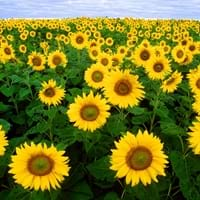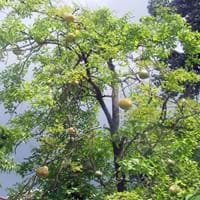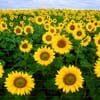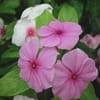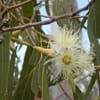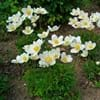Life Span
Annual
Perennial
Type
Flowering Plants
Fruits, Tree
Origin
North America
Hybrid origin, Southeast Asia, Southern India
Types
Helianthus annuus, Heliantheae,
Kaghzi Mirzapuri, Kaghzi Gonda, Kagzi Etawah and Kagzi Banarasi
Habitat
Dry areas, Open areas, Prairies
Tropical Climate, Tropical regions, Wet forest
USDA Hardiness Zone
3-10
9-15
Sunset Zone
A1, A2, A3, H1, H2, 1a, 1b, 2a, 2b, 3a, 3b, 4, 5, 6, 7, 8, 9, 10, 11, 12, 13, 14, 15, 16, 17, 18, 19, 20, 21, 22, 23, 24
H1, H2, 12, 13, 16, 17, 18, 19, 20, 21, 22, 23, 24
Habit
Upright/Erect
Upright/Erect
Flower Color
Brown, Yellow
White, Yellow green
Flower Color Modifier
Bicolor
Not Available
Fruit Color
Black, Chocolate, Ivory
Green, Brown
Leaf Color in Spring
Dark Green, Green
Green, Ivory
Leaf Color in Summer
Green
Green, Ivory
Leaf Color in Fall
Green
Green, Ivory
Leaf Color in Winter
Not Available
Green, Ivory
Leaf Shape
Oval
Trident shaped
Plant Season
Summer
Spring, Summer, Fall, Winter
Sunlight
Bright direct sunlight
Full Sun, Partial Sun
Growth Rate
Very Fast
Fast
Type of Soil
Dry, Light, Well drained
Loam, Sand
The pH of Soil
Acidic, Alkaline
Neutral
Soil Drainage
Well drained
Well drained
Bloom Time
Early Fall, Early Summer, Fall, Late Spring, Late Summer, Summer
Indeterminate
Tolerances
Not Available
Not Available
Where to Plant?
Container, Ground, Pot
Ground
How to Plant?
Seedlings
Stem Cutting
Plant Maintenance
Medium
Low
Watering Requirements
Keep the ground moist but not water-logged, Requires regular watering, Requires watering in the growing season
Needs good drainage, Reduce water once established
In Summer
Lots of watering
Lots of watering
In Spring
Moderate
Moderate
In Winter
Average Water
Average Water
Soil pH
Acidic, Alkaline
Acidic, Neutral
Soil Type
Dry, Light, Well drained
Clay, Loam, Sand
Soil Drainage Capacity
Well drained
Well drained
Sun Exposure
Bright direct sunlight
Partial Sun, Partial shade
Pruning
Prune ocassionally, Requires little pruning
Cut upper 1/3 section when young to enhancegrowth, Remove dead branches
Fertilizers
All-Purpose Liquid Fertilizer
General purpose fertilizer with an NPK ratio 3-1-2
Pests and Diseases
Alternaria leaf blight, Apical chlorosis, Bacteria wilt, Bacterial leaf spot, Botrytis head rot, Charcoal rot, Crown gall, Downy mildew, Erwinia stalk rot, Fusarium stalk rot, Fusarium wilt, head rot, Phialophora yellows, Stem spot
Aphids, Downy mildew, fungus
Plant Tolerance
Drought
Full Sun, Soil Compaction
Flower Petal Number
Single
Single
Foliage Texture
Coarse
Coarse
Foliage Sheen
Matte
Matte
Attracts
Birds, Butterflies
Ants, Birds, Leafminer, Not Available, Squirrels
Allergy
Runny nose, Red eyes, Watery eyes, Sore eyes, Itchy eyes
Dizziness, Stomach pain
Aesthetic Uses
Beautification, Bouquets, Showy Purposes, Used for decorating walls, fences, gates, hedges, etc.
Beautification, Showy Purposes
Beauty Benefits
Not Available
Not Available
Environmental Uses
Air purification
Air purification
Medicinal Uses
Pulmonary afflictions
Antiasthamatic, Antirheumatic, Arthritis, Dermatitis
Part of Plant Used
Flowers, Seeds, Stem
Leaves
Other Uses
As Fertilizers, Economic Purpose, Oil is used in perfume, soaps, creams, etc., Showy Purposes, Used As Food, Used as Ornamental plant, Used for producing cooking oil
Used as Ornamental plant, Used for its medicinal properties
Used As Indoor Plant
Yes
No
Used As Outdoor Plant
Yes
Yes
Garden Design
Bedding Plant, Bonsai, Container, Edging, Edible, Feature Plant, Houseplant, Vegetable
Container, Feature Plant, Mixed Border, Tropical
Botanical Name
Helianths Annuus
Aegle marmelos
Common Name
Sunflower
Bael , Bengal Quince, Wood apple
In Hindi
Sūrajamukhī
बिल्व, बेल, बेलपत्थर,
In German
Sonnenblume
Bengalische Quitte, Madjobaum
In French
Tournesol
fruit de Beli, Coing du Bengale, Bilva
In Spanish
Girasol
membrillo de Bengala, Bilva
In Greek
ηλιοτρόπιο
Βεγγάλης Κυδώνι
In Portuguese
Girassol
Fruta de Bael
In Polish
słonecznik
Kleiszcze smakowite
In Latin
Helianthus
Bilwa
Phylum
Magnoliophyta
Magnoliophyta
Class
Magnoliopsida
Magnoliopsida
Order
Asterales
Solanales
Family
Asteraceae
Solanaceae
Genus
Heilanthus
Brugmansia
Clade
Not Available
Angiosperms, Asterids, Eudicots
Tribe
Heliantheae
Datureae
Subfamily
Helianthodeae
Solanoideae
Number of Species
Not Available
Importance of Sunflower and Bael
Want to have the most appropriate plant for your garden? You might want to know the importance of Sunflower and Bael. Basically, these two plants vary in many aspects. Compare Sunflower and Bael as they differ in many characteristics such as their life, care, benefits, facts, etc. Every gardener must at least have the slightest clue about the plants he wants to plant in his garden. Compare their benefits, which differ in many ways like facts and uses. The medicinal use of Sunflower is Pulmonary afflictions whereas of Bael is Antiasthamatic, Antirheumatic, Arthritis and Dermatitis. Sunflower has beauty benefits as follows: Not Available while Bael has beauty benefits as follows: Not Available.
Compare Facts of Sunflower vs Bael
How to choose the best garden plant for your garden depending upon its facts? Here garden plant comparison will help you to solve this query. Compare the facts of Sunflower vs Bael and know which one to choose. As garden plants have benefits and other uses, allergy is also a major drawback of plants for some people. Allergic reactions of Sunflower are Runny nose, Red eyes, Watery eyes, Sore eyes and Itchy eyes whereas of Bael have Dizziness and Stomach pain respectively. Having a fruit bearing plant in your garden can be a plus point of your garden. Sunflower has no showy fruits and Bael has no showy fruits. Also Sunflower is flowering and Bael is not flowering . You can compare Sunflower and Bael facts and facts of other plants too.
